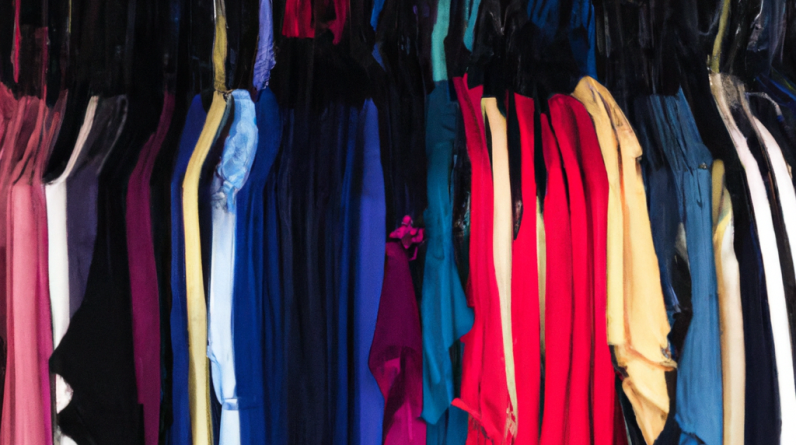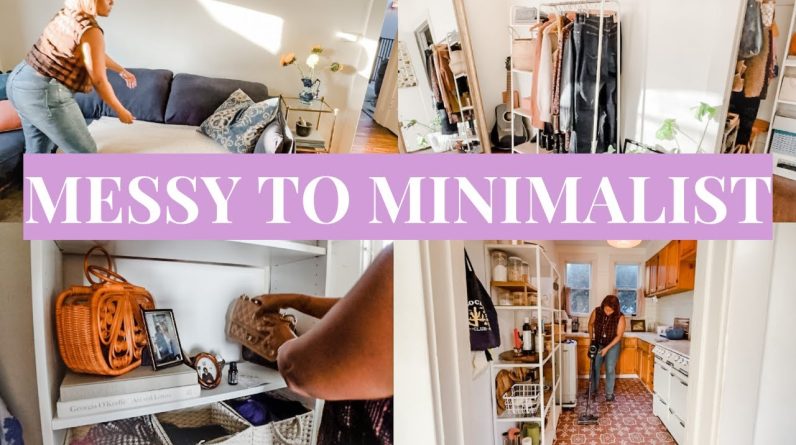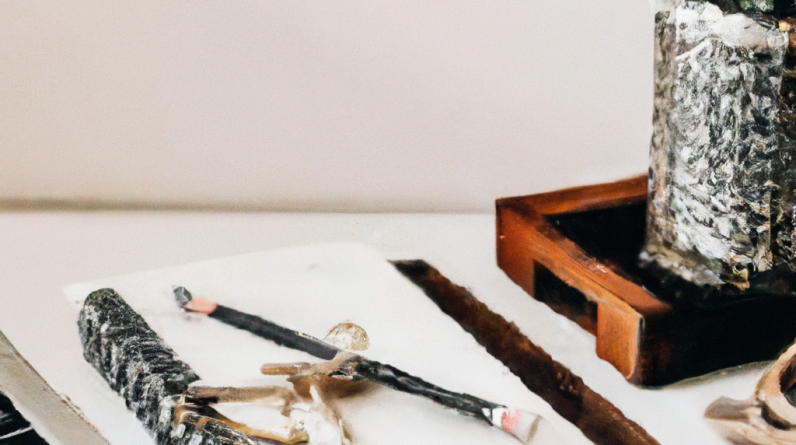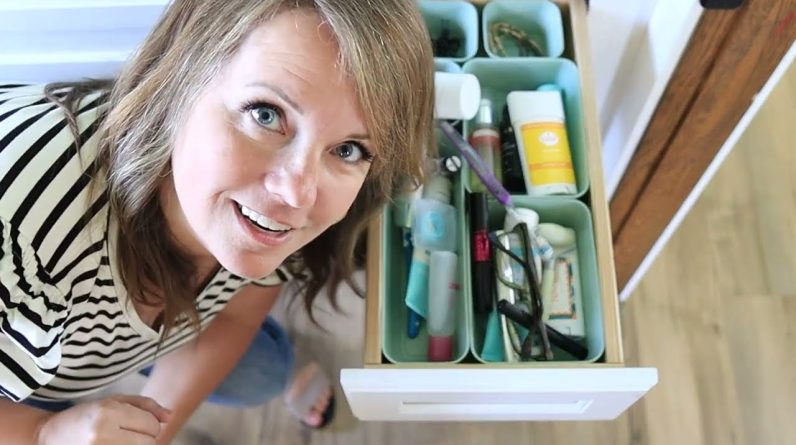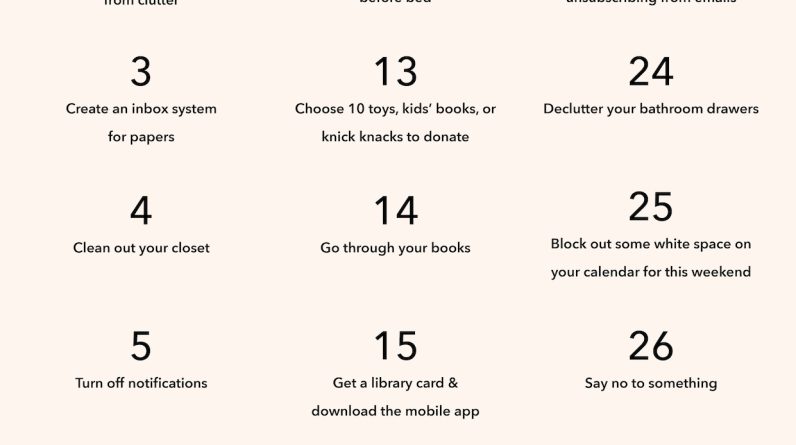
Are you feeling overwhelmed by the clutter in your life? Looking for a way to simplify and create a more peaceful environment? Look no further. The 30 Day Minimalism Challenge is here to help you declutter your space and clear your mind. Over the course of 30 days, you’ll be guided through a series of simple yet effective tasks to help you let go of the excess and embrace a more minimalist lifestyle. Get ready to embark on a journey of transformation and discover the joy of living with less.
Table of Contents
Day 1: Clearing Out Your Wardrobe
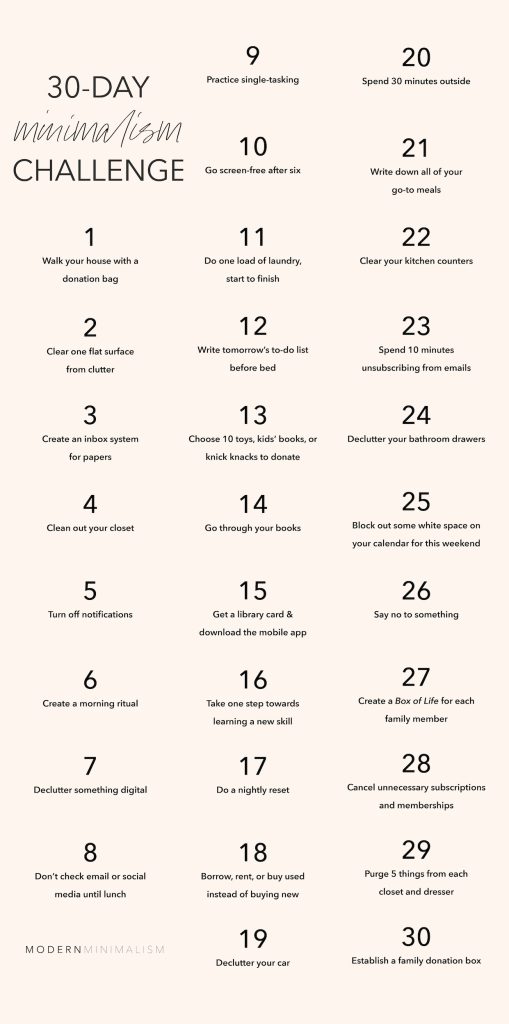
This image is property of modernminimalism.com.
Assessing your current wardrobe
When it comes to decluttering your wardrobe, the first step is to assess what you currently own. Take everything out of your closet and lay it out on your bed or any spacious area. This way, you’ll be able to see your entire wardrobe at once and get a clear picture of what you have.
Sorting clothes into keep, donate, and sell piles
Once you have everything out in the open, it’s time to start sorting your clothes into different piles. The first pile should be items that you definitely want to keep. These are the pieces that you wear regularly and absolutely love.
The second pile should consist of clothes that you no longer wear or that don’t fit you well. These items can be donated to charities or given to friends who might enjoy them. Remember, just because an item doesn’t work for you anymore doesn’t mean it won’t be loved by someone else.
Lastly, create a sell pile for items that are in good condition but no longer serve you. You can sell these pieces online or at a consignment store. This way, you can make a little extra cash while decluttering.
Creating a minimalist capsule wardrobe
To truly embrace minimalism in your wardrobe, consider creating a capsule wardrobe. A capsule wardrobe is a simplified collection of versatile and timeless pieces that can easily be mixed and matched. It typically consists of around 30-40 items, including tops, bottoms, dresses, and outerwear.
When curating your capsule wardrobe, focus on quality over quantity. Invest in well-made pieces that will last longer and take up less space in your closet. Choose neutral colors and classic silhouettes that can be dressed up or down, allowing you to create a variety of outfits with just a few key items.
Remember, the goal of a minimalist wardrobe is to have fewer items that bring you joy and serve a purpose, rather than a closet overflowing with clothes you rarely wear.
Day 2: Decluttering Your Kitchen
Organizing your pantry
The first step in decluttering your kitchen is to tackle your pantry. Start by taking everything out and cleaning the shelves. As you put items back, check expiration dates and toss anything that’s past its prime.
Organize your pantry by grouping similar items together. Use clear storage containers to store dry goods like pasta, rice, and cereals. This not only keeps your pantry looking tidy but also makes it easier to see what you have and avoid buying duplicates.
Getting rid of unused utensils and appliances
A cluttered kitchen can make cooking and meal preparation feel stressful. Take some time to go through your utensil drawer and kitchen cabinets to get rid of any items you no longer use or need. Be honest with yourself about what you actually use on a regular basis.
Donate or give away any duplicate utensils or appliances that are taking up unnecessary space. Stick to the essentials and keep only the items that you truly love and use frequently.
Streamlining your cooking and dining essentials
Lastly, streamline your cooking and dining essentials. Take a look at your collection of pots, pans, and dishes. If you find that you have an excessive amount of kitchenware, consider downsizing to a few versatile pieces that can serve multiple purposes.
When it comes to dining essentials, keep a set of dishes and cutlery that can accommodate your family or guests. Avoid hoarding excessive amounts of mismatched plates and glasses. Instead, opt for a simple and cohesive set that will enhance your dining experience without cluttering your kitchen.
Day 3: Simplifying Your Bathroom

This image is property of images.squarespace-cdn.com.
Sorting through toiletries and cosmetics
It’s time to tackle your bathroom and streamline your collection of toiletries and cosmetics. Start by emptying out your drawers and cabinets and sorting through each item. Get rid of anything that is expired, unused, or no longer brings you joy. This includes old makeup, expired medications, and half-empty bottles of shampoo or lotion.
When it comes to toiletries, try to keep only the essentials. If you have multiples of the same item, like shampoos or lotions, consolidate them to avoid unnecessary clutter. Consider using refillable containers for your products to reduce packaging waste and create a more visually pleasing bathroom space.
Organizing bathroom storage
To create a more organized bathroom, invest in storage solutions that fit your space and needs. Drawer dividers, spice racks, and over-the-door organizers can help maximize your storage space and keep everything neatly organized.
Sort your items into categories and assign designated spots for each. Keep frequently used items within easy reach and store less frequently used items higher up or in the back of cabinets. This way, you’ll have a more functional bathroom space and spend less time searching for what you need.
Streamlining daily essentials
To further simplify your bathroom, consider streamlining your daily essentials. Choose multipurpose products whenever possible to reduce the number of items you need to keep on hand. Look for skincare and haircare products that serve multiple functions, such as a moisturizer with SPF or a shampoo and conditioner combo.
By focusing on the essentials and decluttering unnecessary items, you’ll create a more calming and clutter-free bathroom environment that promotes relaxation and self-care.
Day 4: Clearing Out Your Bookshelf

This image is property of www.theminimalists.com.
Assessing your book collection
If you’re a book lover, chances are you have a bookshelf filled with beloved titles. But as with any collection, it’s important to periodically assess what you truly enjoy and what no longer sparks joy.
Take each book off the shelf and really think about whether or not you’ll read it again. Keep the books that hold sentimental value or that you genuinely love and plan to reread. Consider donating or selling books that you no longer need or that you’re unlikely to revisit.
Donating or selling books you no longer need
Once you’ve identified the books you’re ready to part with, consider donating them to a local library, school, or charity. Many organizations welcome book donations and appreciate the opportunity to provide reading material to others.
If you have books that are in good condition and still sought after, you can also sell them online or at a used bookstore. This not only helps declutter your space but also gives someone else the chance to enjoy those books.
Organizing remaining books in a minimalist way
After decluttering your book collection, it’s time to organize the remaining books in a minimalist way. Consider arranging them by genre, author, or color for a visually pleasing display. You can also use bookends or mix in decorative accents to add interest to your bookshelf.
Avoid overcrowding your shelves and leave some empty space to create a more airy and clutter-free look. Remember, the goal is to have a curated collection of books that you love and that enhance your space, rather than a shelf overflowing with books that rarely see the light of day.
Day 5: Decluttering Your Workspace

This image is property of teresaannmoon.com.
Organizing desk drawers and shelves
A cluttered workspace can impact your productivity and focus. Start by organizing your desk drawers and shelves. Take everything out and sort through the items, keeping only what you need and use regularly.
Invest in desk organizers or drawer dividers to keep items like pens, paper clips, and cords neatly separated. Utilize wall-mounted shelves or floating shelves to free up desk space and keep frequently used items within easy reach.
Reducing paper clutter
One of the main sources of clutter in a workspace is paper. Take the time to go through all the papers on your desk and sort them into three categories: Keep, File, and Recycle.
The “Keep” category should contain only essential documents that you need to have on hand. Items like receipts, bills, and important letters fall into this category. The “File” category is for papers that need to be stored for future reference but aren’t needed for immediate use. The “Recycle” category is for papers that are no longer needed and can be safely disposed of.
Consider digitizing important documents to further reduce paper clutter. Scan receipts, invoices, and other important paperwork and save them in organized folders on your computer or cloud storage.
Creating a minimalist and inspiring workspace
To create a minimalist and inspiring workspace, focus on keeping only what you truly need and love. Keep your desk surface clean and clutter-free, with only the essentials within reach.
Add a touch of personalization to your workspace with a small plant, a favorite photo, or a motivational quote. Keep your computer desktop organized with folders and only have the necessary shortcuts visible. A clean and tidy workspace will not only enhance your productivity but also create a more enjoyable and stress-free work environment.
Day 6: Streamlining Your Digital Life

This image is property of images.squarespace-cdn.com.
Deleting unnecessary files and documents
In today’s digital age, it’s easy for our devices to become cluttered with unnecessary files and documents. Take some time to go through your computer, phone, and other devices to delete anything you no longer need.
Start with your downloads folder and move on to other folders like documents, photos, and videos. Be ruthless in getting rid of duplicates, outdated files, and anything else that is taking up valuable storage space.
Unsubscribing from email newsletters and subscriptions
An overflowing inbox can be overwhelming and time-consuming to manage. Take a moment to go through your email subscriptions and unsubscribe from newsletters or promotional emails that you no longer find useful or interesting.
Consider creating folders or labels to organize important emails and prioritize your inbox. This will help you stay focused on what truly matters and reduce the clutter in your digital life.
Organizing digital files and folders
Once you’ve decluttered your digital devices, it’s time to organize your files and folders. Create a hierarchical structure that makes sense to you, with broad categories and subfolders as needed. This will make it easier to find specific files when you need them.
Consider using cloud storage solutions like Google Drive or Dropbox to store important files, ensuring they’re backed up and easily accessible from any device. This way, you can reduce the clutter on your physical devices and have peace of mind knowing that your important files are safely stored in the cloud.
Day 7: Simplifying Your Living Room
Getting rid of excess furniture
The living room is often the heart of a home, but it’s easy for it to accumulate excess furniture that can make the space feel cluttered. Take a look at your living room and consider if there are any pieces of furniture that aren’t truly necessary or that you no longer love.
If you have a surplus of chairs, side tables, or other furniture items, consider donating or selling them. Pare down your living room to the essential furniture pieces that provide comfort and functionality, creating a more open and inviting space.
Clearing out unnecessary décor items
Too many knick-knacks and decorative items can quickly make a living room feel cluttered and overwhelming. Assess your décor items and keep only the ones that you truly love and that bring you joy.
Consider displaying one or two statement pieces that can act as conversation starters or focal points in the room. This can be a piece of artwork, a unique vase, or a sentimental item that holds special meaning to you. Remember, less is often more when it comes to creating a calming and clutter-free living space.
Creating a calming and clutter-free living space
To create a calming and clutter-free living space, focus on simplicity and functionality. Keep the room well-organized by regularly tidying up and putting items away when they’re not in use.
Invest in smart storage solutions like ottomans with hidden compartments or bookshelves with storage baskets to keep everyday items within reach but out of sight. Choose neutral colors and natural materials for furniture and décor to create a sense of tranquility and balance in the room.
By decluttering your living room and embracing minimalism, you’ll create a space that promotes relaxation, connection, and a sense of calm.
Day 8: Clearing Out Your Medicine Cabinet
Checking for expired medications
Expired medications can be dangerous if consumed, so it’s important to regularly check your medicine cabinet and dispose of any expired medications. Take each item out and check the expiration date. Any medications that have expired should be safely disposed of.
Most communities have disposal programs or guidelines for proper medication disposal. Look into local resources or contact your pharmacy or healthcare provider for guidance on how to properly dispose of expired medications in your area.
Getting rid of unused or duplicate items
Next, take a look at the items in your medicine cabinet that you no longer need or that you have multiples of. This includes things like unused band-aids, duplicate first aid items, or half-empty bottles of over-the-counter medications.
Donate any unopened and unexpired items to local shelters, charities, or healthcare clinics. If you have partially used items that you no longer need, consider sharing them with friends or family members who can make use of them.
Organizing medicines and first aid supplies
Once you’ve decluttered your medicine cabinet, it’s time to organize the remaining items. Keep like items together and consider using labeled bins or dividers to separate different categories.
Ensure that medications are stored in a cool, dry place, away from direct sunlight. Keep first aid supplies easily accessible and consider designating a specific shelf or area for them.
Regularly check your medicine cabinet to make sure items are still in good condition and within their expiration dates. This will ensure that you have a well-organized and functional space for all your medical and first aid needs.
Day 9: Decluttering Your Garage or Storage Space
Sorting through stored items
The garage or storage space is often a place where items get stuffed and forgotten. To declutter this area, start by taking everything out and sorting through each item.
Separate items into categories such as tools, outdoor equipment, seasonal decorations, and household goods. This will give you a clear idea of what you have and what can be decluttered.
Donating or selling unused belongings
Once you’ve sorted through your stored items, consider donating or selling anything that you no longer need or use. Many organizations accept donations of tools, sports equipment, and household goods.
If you have items that are in good condition but no longer serve you, consider selling them online or at a garage sale. This will not only help you declutter your storage space but also give someone else the opportunity to enjoy those items.
Creating a functional and organized storage area
To create a functional and organized storage area, invest in storage solutions that fit your needs. Use shelving units, hooks, and bins to maximize vertical space and keep items off the floor.
Label boxes and bins so you know exactly what’s inside and can easily find what you’re looking for. Take advantage of wall space by installing pegboards or wall-mounted hooks to hang tools and other frequently used items.
By decluttering and organizing your garage or storage space, you’ll create a more functional and accessible area that allows you to easily find and store items as needed.
Day 30: Decluttering Your Personal Documents
Shredding unnecessary papers
Personal documents can quickly pile up and clutter your space. Take this opportunity to go through your documents and shred anything that is no longer necessary to keep. This includes bank statements, old utility bills, and outdated insurance policies.
Invest in a quality shredder or look for shredding events in your community where you can safely dispose of sensitive documents. This will not only declutter your space but also protect your personal information from falling into the wrong hands.
Organizing important documents
After shredding unnecessary papers, it’s time to organize your important documents. Gather items like birth certificates, passports, social security cards, and other vital records and keep them in a secure and easily accessible location, such as a fireproof safe.
Consider creating a filing system for other important documents like tax returns, medical records, and insurance policies. Use labeled folders or binders to keep everything organized and easily accessible when needed.
Creating a minimalist filing system
To maintain a minimalist and clutter-free filing system, take some time to go through your existing files and remove anything that is no longer relevant or necessary. Keep only the most recent and important documents, discarding duplicates or outdated versions.
Consider digitizing important documents and storing them securely on your computer or in cloud storage. This can help reduce paper clutter and make it easier to find and access important files when needed.
By decluttering and organizing your personal documents, you’ll create a streamlined system that allows you to stay on top of important paperwork and reduce the stress that comes with a cluttered space.
Taking on a 30-day minimalism challenge can have a transformative impact on your life. By systematically decluttering and simplifying each area of your home and life, you’ll create more space, reduce stress, and cultivate a sense of calm and clarity. Remember, minimalism is not about depriving yourself of things you love, but rather about surrounding yourself with only what brings you joy and truly serves a purpose. So grab a bag, start decluttering, and embrace the beauty of a minimalist lifestyle.




